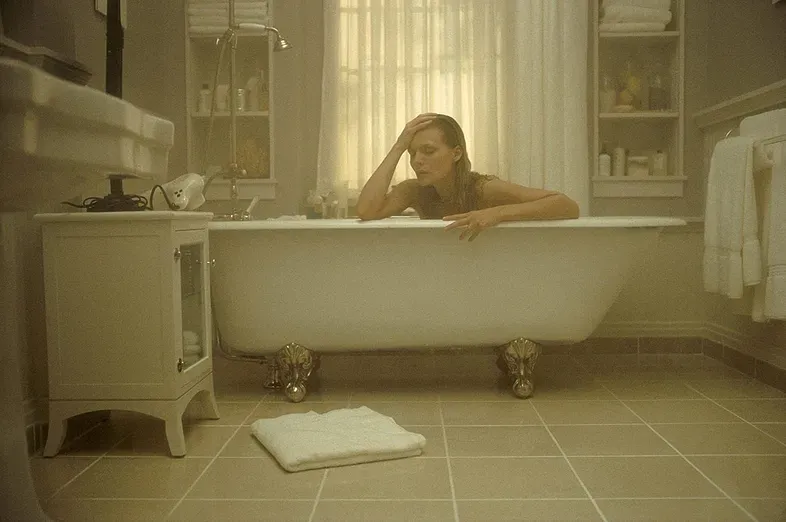Did the Trailer for ‘What Lies Beneath’ Ruin the Movie?
Plenty of trailers give away too many twists and turns. But can a trailer give away a film's heart and soul? A 25-year-old Robert Zemeckis movie might have the answer.

Robert Zemeckis’ horror movie What Lies Beneath has haunted me since I first saw it in the summer of 2000, but not for the right reasons. I did not care for it at the time, but I’ve also wondered if I would have felt differently were it not for the film’s trailer, which I think might have ruined the movie for me (and for everyone who saw it before watching What Lies Beneath). When I say “ruined,” I don’t mean “spoiled.” The trailer inarguably does that. And with that warning out of the way, take a moment to watch the trailer before pressing on (and, if haven’t seen the movie and don’t want to be spoiled, turn back now):
Here’s what you learn from the trailer: Harrison Ford and Michelle Pfeiffer play, respectively, Norman and Claire Spencer, new empty nesters who enjoy having sex with one another and have more opportunities to do so now that their daughter has left for college. That’s good. But Claire’s been hearing and seeing odd things, things that may have something to do with a woman who disappeared about a year ago. That’s unnerving. We’re one minute in and I’m intrigued. Are you intrigued?
Then, at the 80-second mark, things take a spoiler-y turn. We hear Norman confessing to an affair with the missing woman, named Madison (Amber Valletta). “He was the perfect husband,” on-screen text adds, somewhat redundantly, “until his one mistake followed them home.”
So, at this point we know that a) there is a ghost and b) it’s seemingly after Norman. That’s quite a lot of the plot. It’s admittedly not everything. Much of the film’s final act involves Norman trying to kill Claire to cover up his past crimes, a turn at which the trailer only hints. Still, what the trailer does reveal feels like a bigger deal than in most trailers that give too much away. (Like, for instance, the trailer to Zemeckis’ Cast Away, which features footage after Tom Hanks is rescued from the island.)
The Reveal is a reader-supported newsletter dedicated to bringing you great essays, reviews and conversation about movies. While both free and paid subscriptions are available, please consider a paid subscription to support our long-term sustainability.
That only becomes apparent, however, when watching What Lies Beneath. Norman’s confession to the affair doesn’t arrive until one hour and 14 minutes into What Lies Beneath’s 130-minute run time. Until then the film, written by Clark Gregg from a story credited to Gregg and Sarah Kernochan, offers a series of fake-outs and misdirections, slowly unveiling new details. This is Zemeckis’ Hitchcock homage and, in the early going, it seems like its deepest debt belongs to Rear Window. Unsure what’s going on with her neighbors Walter (James Remar) and Mary (Miranda Otto), Claire spies on them and compiles enough damning evidence to accuse Walter of killing his wife in public. (She’s wrong.) Both Rebecca and Psycho can be felt, too, the latter particularly in What Lies Beneath’s fixation on all the horrible things that can happen in a bathroom, albeit with a clawfoot tub instead of a shower.

The opening stretch is clever and patient. It’s the best part of the movie, though when I saw What Lies Beneath for the first time, it felt like a lot of water-treading. I’m loath to revisit my old reviews, particularly those from 25 years ago, but here’s what I wrote when I covered the film for The A.V. Club:
Left alone, she begins to hear mysterious noises and embarks on a Rear Window-style investigation of a new neighbor who appears to have murdered his wife. But, as anyone who's seen the film's overly revealing trailer knows, it's not so simple…
I clearly had the trailer in my head watching the movie. And I’m not alone, either. I took a completely unscientific look at the film’s reviews at the time and maybe it’s a coincidence that the most positive review I found, Lou Lemnick’s in the New York Post, didn’t mention the trailer at all. But Elvis Mitchell’s review in The New York Times did, claiming “[t]he only surprise in this picture is its audacious torpor; the trailer gives away everything but the price of the large popcorn and Diet Coke special.” And Roger Ebert devoted an entire paragraph to the fact he knew too much, noting he was being careful not to reveal too much but also that:
That’s more than the ads have done. The trailer of this movie thoroughly demolishes the surprises; if you’ve seen the trailer, you know what the movie is about, and all of the suspense of the first hour is superfluous for you, including major character revelations. Don’t directors get annoyed when they create suspense and the marketing sabotages their efforts? The modern studio approach to trailers is copied from those marketing people who stand in the aisles of supermarkets, offering you a bite of sausage on a toothpick. When you taste it, you know everything there is to be known about the sausage, except what it would be like to eat all of it. Same with the trailer for “What Lies Beneath.” I like the approach where you can smell the sausage but not taste it. You desire it just as much, but the actual experience is still ahead of you. Trailers that give us a smell and not a taste; that’s what we need.
That’s a good rule for trailers and I generally dislike trailers that give away too much. In fact, I hardly ever watch them unless I’m a captive audience in a theater for this reason. I know, for instance, too many of the plot beats in the upcoming movie Drop already, thanks to the trailer. Still, I’m looking forward to that movie. Even if some of the twists have been spoiled, I don’t feel like it’s been ruined.

There’s something specifically ruinous about the What Lies Beneath trailer, or at least something about it that’s made me question whether I misjudged the film every time I’ve thought about it since 2000. What Lies Beneath comes from a stretch when a new Robert Zemeckis movie was exciting. It’s not that every movie Zemeckis made between I Wanna Hold Your Hand and Contact was great, but many were. Zemeckis sandwiched the production of What Lies Beneath between the two rounds of shooting Cast Away. Sure, he’d spend the next decade making dubious computer animated films, but we didn’t know that then. Zemeckis was in his prime at that moment and it seemed like he was ramping up his ambition. I don’t know to what degree Zemeckis helped shape the trailer — I have to imagine that a filmmaker of his stature had more than a little input — but I don’t get how it’s possible to make a film that lives or dies on uncertainty and slow-building suspense then decide to just, to borrow Ebert’s analogy, stick the best chunks on a toothpick and give it away.
That said, maybe there wasn’t that much to ruin. I have no way of retroactively unseeing the trailer but I thought watching the film for the first time in a quarter century might give me a fresher perspective. On one hand, I think I’m right to have spent those 25 years wondering if the trailer colored my view of the movie. Watching it again, I found myself second-guessing my original opinion — and a review that included cheap-shot lines like “There's a dog named Cooper who at one point manages a more soulful expression than either of his human costars.” That’s unfair to Pfeiffer, who’s quite good, and Ford, whose semi-checked out performance seems appropriate for a character who’s not being honest with his wife. (Though Cooper is pretty good.) Still, the characters feel a bit thin, and Ford’s heel turn in particular never seems plausible.
Nonetheless, I enjoyed the slow ramping up of tension in the film’s opening stretch. And though the action-packed climax goes on too long, it begins with one of the best set pieces of Zemeckis’ career. Drugged by a “dissociative agent” described earlier in the film as paralyzing those exposed to it while keeping them conscious and aware of their surroundings, Claire watches helplessly as her bathtub fills with water. Only the slowly returning ability to control her big toe might allow her to escape before she drowns. It’s terrifically tense. It’s also a standout moment in a back half that’s louder and faster than the first half, yet still pretty tedious. I left the film feeling more or less as I felt after seeing it in 2000. It’s a just-OK movie that should have been better.
Or maybe that feeling, too, can be traced to the trailer that revealed too much. I’ll never know for sure.




Discussion